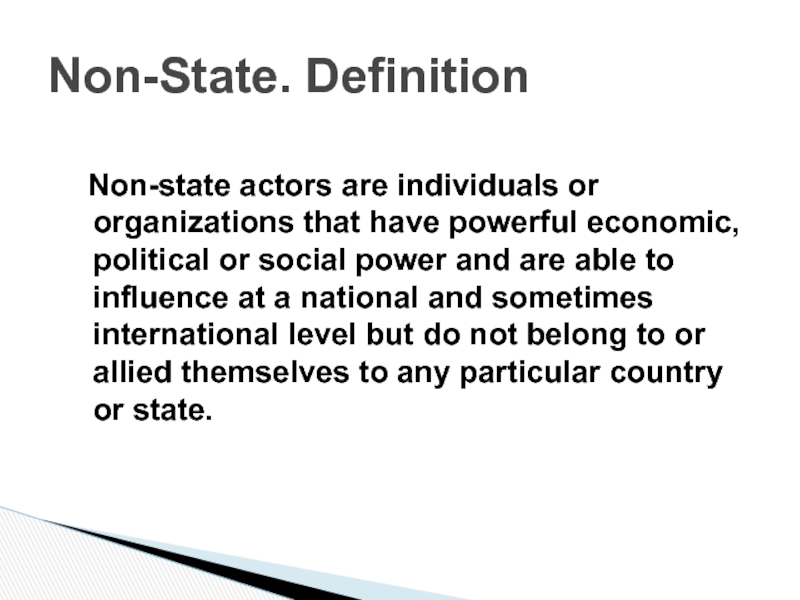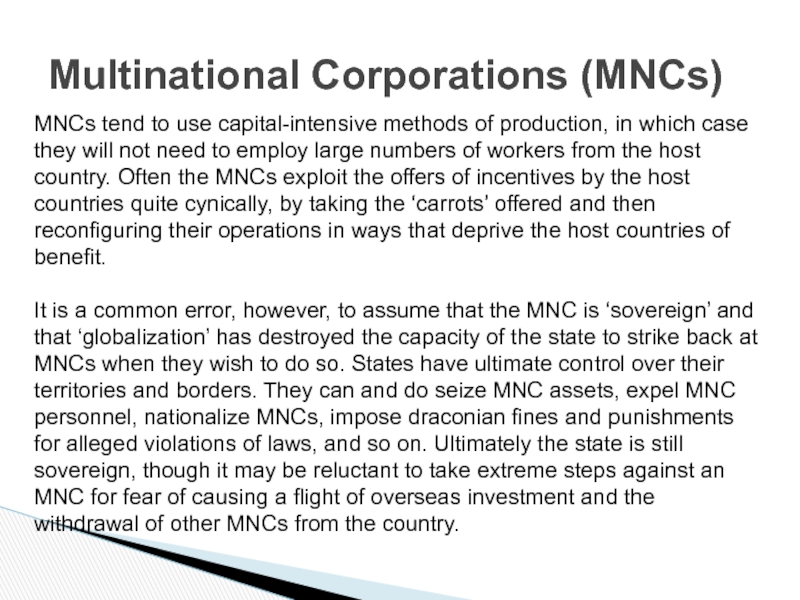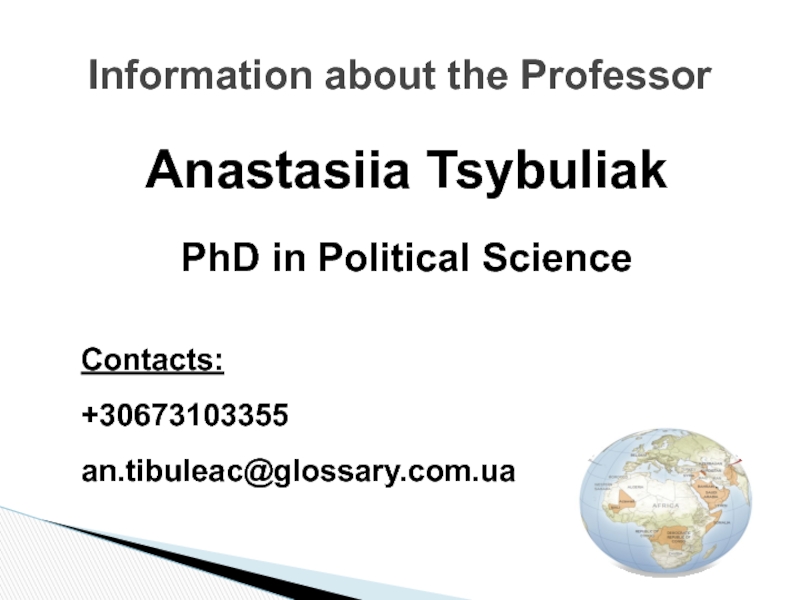- Главная
- Разное
- Дизайн
- Бизнес и предпринимательство
- Аналитика
- Образование
- Развлечения
- Красота и здоровье
- Финансы
- Государство
- Путешествия
- Спорт
- Недвижимость
- Армия
- Графика
- Культурология
- Еда и кулинария
- Лингвистика
- Английский язык
- Астрономия
- Алгебра
- Биология
- География
- Детские презентации
- Информатика
- История
- Литература
- Маркетинг
- Математика
- Медицина
- Менеджмент
- Музыка
- МХК
- Немецкий язык
- ОБЖ
- Обществознание
- Окружающий мир
- Педагогика
- Русский язык
- Технология
- Физика
- Философия
- Химия
- Шаблоны, картинки для презентаций
- Экология
- Экономика
- Юриспруденция
Non-State. Definition презентация
Содержание
- 1. Non-State. Definition
- 2. Non-States Session 8
- 3. Non-state actors are individuals
- 4. Pearlman and Cunningham: non-state
- 5. All the world’s major religions originated
- 6. On the one hand, Christianity, Islam, and
- 7. ‘Clash of Civilizations’ thesis by Samuel Huntington
- 8. Religions Religious organizations are growing in their
- 9. 2. Religious organizations exercise a
- 10. Religions 3. Even more powerfully,
- 11. The term ‘nations’ had no political significance
- 12. Cultural-linguistic nationalism The newly independent nations, like
- 13. Multinational Corporations (MNCs) MNCs tend
- 14. Guerrilla warfare is the natural weapon of
- 15. Terrorist groups, according to the Council
- 16. Terrorist groups, according to the Council Kurdistan
- 17. Selected top 100TNCs, ranked by transnationality index
- 18. Karen A. Mingst, Ivan M. Arreguin-Toft. Essentials
- 19. Information about the Professor Anastasiia Tsybuliak PhD in Political Science Contacts: +30673103355 an.tibuleac@glossary.com.ua
Слайд 3
Non-state actors are individuals or organizations that have powerful
Non-State. Definition
Слайд 4
Pearlman and Cunningham: non-state actors are define as “an organized political
Non-State. Definition
Слайд 5
All the world’s major religions originated before the emergence of the
Religion has been the single most powerful influence not only on societal values, morality, and the norms and practices of family and community life: it has also had a major impact on the nature of the state itself, its laws and institutions and processes of government.
Religions
Слайд 6On the one hand, Christianity, Islam, and Judaism have all inspired
On the other, religions have motivated and inspired some of the most brutal inter-state and internal wars and terrorist campaigns.
Religions
Слайд 7‘Clash of Civilizations’ thesis by Samuel Huntington
The fundamental source of conflict...
The most important countries in the world come overwhelmingly from different civilizations. The local conflicts most likely to escalate into broader wars are those between groups and states from different civilizations ... The key issues on the international agenda involve differences among civilizations.
Quoted from Huntington (1993, 1996)
Religions
Слайд 8Religions
Religious organizations are growing in their power to shape public debate
Слайд 9 2. Religious organizations exercise a transnational influence upon the
Religions
Слайд 10
Religions
3. Even more powerfully, religion shapes not only the policies of
Слайд 11The term ‘nations’ had no political significance until the late 18th
Rousseau and the Jacobins asserted the claims of the whole population to sovereignty over their state, for the first time proposing that the model state was synonymous with the nation.
Principles of national solidarity, universal citizenship, equal rights to civic participation and equal treatment under the law, all underpin the modern doctrine of nationalism.
Nationalism
Слайд 12Cultural-linguistic nationalism
The newly independent nations, like their long-established ex-imperial rulers, rapidly
Anti-colonial nationalism in the ‘Third World’
In many cases, especially in the British colonies, the colonial power’s permissive rule encouraged the formation of nationalist parliamentary parties as a form of ‘democratic tutelage’, and where this happened the mass violence of a revolutionary overthrow of colonial rule was often avoided.
Major forms of nationalist movements
Слайд 13
Multinational Corporations (MNCs)
MNCs tend to use capital-intensive methods of production, in
It is a common error, however, to assume that the MNC is ‘sovereign’ and that ‘globalization’ has destroyed the capacity of the state to strike back at MNCs when they wish to do so. States have ultimate control over their territories and borders. They can and do seize MNC assets, expel MNC personnel, nationalize MNCs, impose draconian fines and punishments for alleged violations of laws, and so on. Ultimately the state is still sovereign, though it may be reluctant to take extreme steps against an MNC for fear of causing a flight of overseas investment and the withdrawal of other MNCs from the country.
Слайд 14Guerrilla warfare is the natural weapon of the strategically weaker side
A key lesson from the recent history of guerrilla warfare, as shown in a masterly survey by Walter Laqueur, Guerrilla, is that it is hardly ever a self-sufficient means of achieving victory.
Most revolutionary wars (for example, in China, Vietnam, and Cambodia) have moved through a guerrilla phase and have finally developed into a decisive struggle between conventional armed forces.
Guerrillas and insurgents
Слайд 15Terrorist groups, according to the Council
Al-Qaeda (Afghanistan, Islamists)
Osama bin Laden
Hannas, Islamic Jihad (Palestinian Islamists)
Al-Aqsa Martyrs Brigades (Palestinian nationalists)
PFLR DFLR PFLP-GC (Palestinian leftists)
Hezbollah (Lebanon, Islamists)
Jamaat al-lslamiyya, Egyptian Islamic Jihad (Egypt, Islamists)
Armed Islamic Group (Algeria, Islamists)
Kashmir Militant Extremists (Kashmir, Islamists)
Mujahedeen-e-Khalq (Iranian rebel)
Abu Nidal Organization (Iraq, extremists)
Kach, Kahane Chai (Israel, extremists)
Chechnya-based Terrorists (Russia, separatists)
East Turkestan Islamic Movement (China, separatists)
Terrorist groups and networks
Слайд 16Terrorist groups, according to the Council
Kurdistan Workers' Party (Turkey, separatists)
Jemaah Islamiyah
Abu Sayyaf Group (Philippines, Islamist separatists)
Liberation Tigers of Tamil Eelam (Sri Lanka, separatists)
Irish Republican Army (UK, separatists)
IRA Splinter Groups (UK, separatists)
Northern Ireland Loyalist Paramilitaries (UK, extremists)
Basque Fatherland and Liberty (Spain, separatists)
November 17, Revolutionary People's Struggle (Greece, leftists)
FARC, ELN, AUC (Colombia, rebels)
Shining Path, Tupac Amaru (Peru, leftists)
Aum Shinrikyo (Japan, cultists)
American Militant Extremists (US, radicals)
Ansaral Islam (Iraq, Islamists/Kurdish separatists)
Terrorist groups and networks
Слайд 17Selected top 100TNCs, ranked by transnationality index 1, 2000
’ The 'transnationality
Based on UNCTAD (2002)
Humanitarian and human rights organizations
Слайд 18
Karen A. Mingst, Ivan M. Arreguin-Toft. Essentials of International Relations. 5th Ed.
Robert Jackson, Georg Sorensen. Introduction to International Relations: Theories and Approaches. 4th edition, 2010: Oxford University Press. ISBN 978-0199548842
Paul Wilkinson. International Relations: A Very Short Introduction (Very Short Introductions). 1st edition. 2007: Oxford Paperbacks. ISBN 978-0192801579
Recommended Literature
























